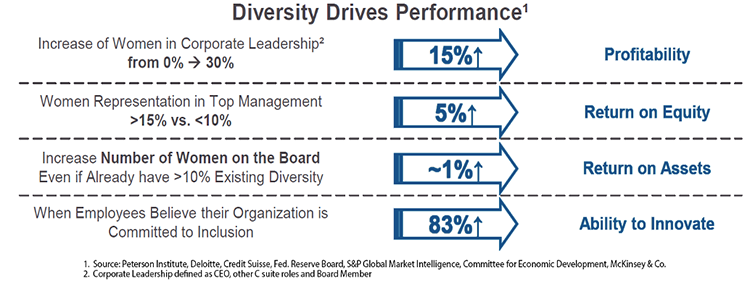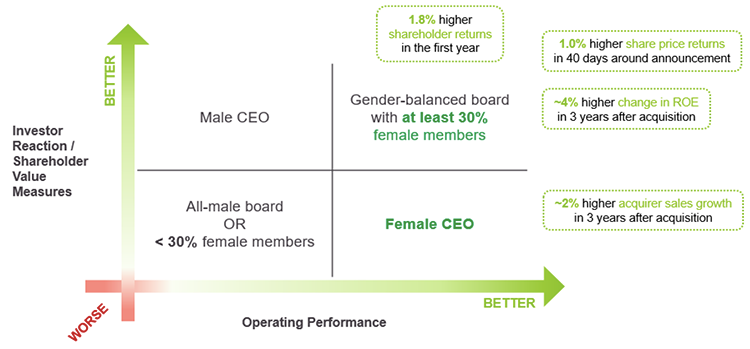
Embracing Gender Diversity as a Pathway to Success
Brought to you by Bank on Women, Inc.

A prolonged flat yield curve, economic contraction, increasing compliance and technology costs, not to mention the pandemic-induced pressure on stock valuations, have left banks in a difficult operating environment with limited opportunities for profitability.
Yet, there is an untapped opportunity for banks to capitalize on a strong and growing talent pool and profitable customer base: women. Research repeatedly shows that increasing gender diversity on bank boards and in C-suites drives better performance. Forward-thinking banks should look to women in their communities for growth inside and outside the institution.
Women now receive nearly 60% of all degrees, make up 50% of the workforce and, prior to the pandemic, held more jobs in the U.S. than men. They are the primary breadwinner in over 40% of U.S. households and comprise more than 50% of stock owners. A McKinsey & Co. report found that U.S. women currently control $10.9 trillion in assets; by 2030, that could grow to as much as $30 trillion in assets. Women also started 1,821 net new businesses a day in 2017 and 2018, employing 9.2 million in 2018 and recording $1.8 trillion in revenues. Startups founded by women pulled in $18.6 billion in investments across 2,304 deals in 2019 – still, lack of capital is the greatest challenge reported by female small business owners.
Broadly, research also supports a positive correlation between a critical mass of gender diversity in leadership and performance.

A study of tech and financial services stocks found a 20% increase in stock price momentum within 24 months of appointing a female CEO, a 6% increase in profitability and 8% larger stock returns with a female CFO. And they may achieve better execution on deals. In a review of 16,763 publicly announced M&A transactions globally over the last 20 years, boards that were more than 30% female performed better in terms of stock price and operational metrics than all-male boards.

Note: Performance metrics are market-adjusted
Source: M&A Research Centre at Cass Business School, University of London and SS&C Intralinks: “Gender Diversity and M&A Outcomes; How Female Board-Level Representation Affects Corporate Dealmaking” (February 2020)
But as of 2018, women held just 40 CEO positions at U.S. public banks, or 4.31%. Nearly 20% of banks have no women board members; the median is just over 16%. Banks should start by gender diversifying their boards; gender-diverse boards lead to gender-diverse C-suites.
Usually, boards feature an “accidental” composition that results from social norms: board members source new directors from their social and immediate networks. An intentional board, by comparison, is deliberate in composing a governance structure that is best equipped to evaluate and address current demands and future challenges. Boards can address this in three ways.
- Expand your networks. The median male board member has social connections to 62% of other men on their boards but no social connections to women on their boards. Broaden the traditional recruitment channels to ensure a more qualified, diverse slate.
- Seek diverse skill sets. Qualified female candidates may emerge through indirect career paths, other sectors of the financial industry or are in finance but outside of financial services. Women with nonprofit experience and small business owners can bring local market knowledge and relevant experience to bank boards.
- Insist on gender diverse slates. A diverse slate of candidates negates tokenism, while a diverse interviewer slate demonstrates to candidates that your bank is diverse.
But diversity in recruiting and hiring alone won’t improve a bank’s performance. To be effective, a diverse board must intentionally engage all members. Boards can address this in three ways.
- Ensure buy-in. Support from key board members when it comes to diversifying your board is critical to success. Provide coaching for inclusive leadership.
- Review director on-boarding and ongoing engagement. Make sure it’s welcoming to people with different connections or social backgrounds, builds trust and facilitates open communication.
- Thoughtful composition of board committees. Integrate new directors into the board’s culture and make corporate governance more inclusive and effective.
The long-term performance benefits of a gender diverse board and c-suite are compelling, especially in the current challenging operating environment for banks. Over time, an intentional board and C-suite that mirrors the gender diversity of your bank’s key constituents – your customer base, your employee base and your shareholder base – will out-perform banks that do not adapt.



